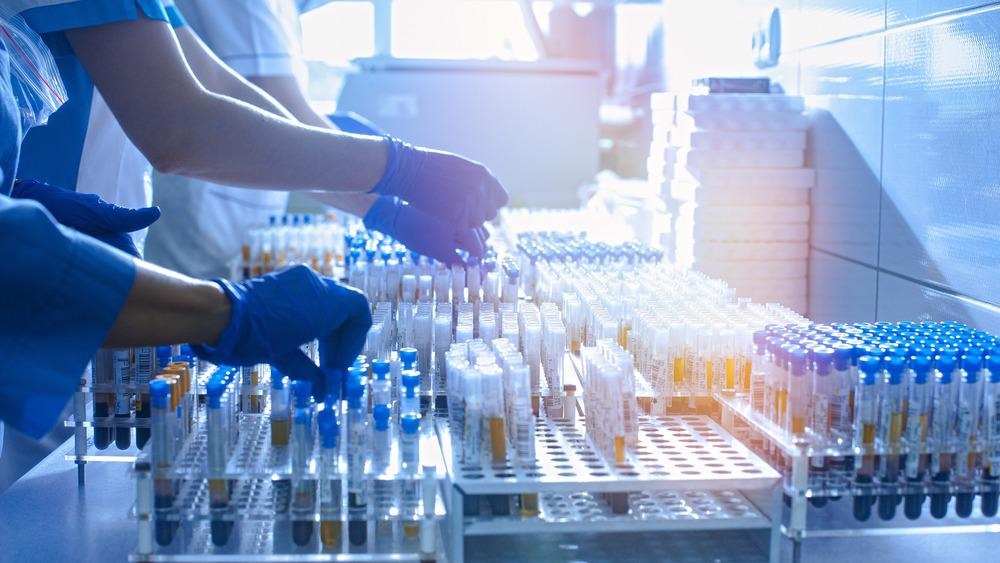The human immune system is complex, with different cells and signaling mechanisms involved in immune responses. A study, currently in pre-proof in the journal Biomaterials, has provided evidence for the release of extracellular traps by macrophages in response to biomaterials, which will help to design better biomaterials for bone regenerative tissue engineering.

Study: Calcium phosphate-based biomaterials trigger human macrophages to release extracellular traps Image Credit: Marina Litvinova/Shutterstock.com
Extracellular Traps
When encountering pathogens and implanted biomaterials, the host’s immune system reacts in specific ways, triggering an immune response to these foreign bodies. Key players in the immune response include neutrophils, macrophages, and monocytes. Several mechanisms such as cytokine release and phagocytosis are used to attract further immune cells to the site of infection.
Another mechanism employed by the immune system to respond to invading bodies and attract immune cells is the release of extracellular traps. This mechanism was first reported in 2004 in neutrophils. An extracellular trap is a sticky, web-like structure. Double-stranded DNA, antimicrobial peptides, histones, and proteases compose these structures. Extracellular traps are analogous to nets.
Recent research has indicated that neutrophils release extracellular traps in response to implanted biomaterials, with the formation of extracellular traps induced by material stiffness, mineral particles, and the hydrophobic nature of biomaterials. Whilst neutrophil responses have been observed in studies, thus far extracellular trap release by macrophages has not.
Immune responses such as extracellular traps govern the effectiveness of biomaterials and whether they will be integrated into the host tissue or encapsulated and separated. A key goal in biomaterials research for medical use is to design effective biomaterials which can prevent excessive immune responses and shift the phenotype of macrophages toward the M2 direction.
Bone Tissue Regeneration
Autologous bone is still the gold standard of biomaterials in bone tissue regenerative medicine. The risk of immunological rejection is low, and autologous bone has the advantage of being osteoconductive. Drawbacks to using this organic material include morbidity at the donor site, additional surgical requirements, potential problems with wound healing, and limited size and quantity.
To overcome these issues, research has focused on synthetic biomimicking materials that can be used to regenerate bone tissue. Calcium phosphate, which is the main inorganic component of human bone tissue, has attracted interest for this purpose and can be used as blocks, injectable cements, or granules.
Aside from the chemical composition and origin of materials, properties such as the porosity of scaffolds are important. Most synthetic scaffolds possess isotropic pore structures, which is unfavorable. Anisotropic pore structures have the advantages of enhanced nutrient transport, improved vascularization, and can facilitate the ingrowth of cells into the scaffolds. Unidirectional freezing can be used to produce scaffolds with highly anisotropic pore structures.
TCP is a commonly used scaffold material for bone regenerative medical applications. However, the immune system responds to these biomaterials by producing cytokines, which cause an inflammatory response, which hinders the safe and effective use of TCP scaffolds for bone regenerative medicine. Therefore, materials that take advantage of the benefits of calcium phosphate without causing a harmful immune response are needed.
The Study
In the study, the authors prepared a calcium phosphate-based biomaterial for bone tissue regeneration and investigated the immune response to the material. The authors froze a slurry of materials under superposition of an external temperature gradient, which resulted in the growth of lamellar and aligned ice crystals. The slurry’s components were displaced and collected between ice crystals. This produced a negative template with a highly ordered and anisotropic pore structure.
The paper has investigated the effects and the unregulated reference of a-TCP and CDHA (calcium deficient hydroxyapatite) on human macrophages. A key finding in the research was the release of mineral nanoparticles from the sample materials, which induced the production of extracellular traps by human macrophage cells. Thus, the research has provided the first evidence of this mechanism in response to biomaterials, and a consequent increase in cytokines.
CDHA upregulates CD206, an M2 marker, whilst decreasing the release of M1 cytokines, especially the anisotropically structured samples. In a-TCP samples, conversely, there was an increase in pro-inflammatory cytokine and macrophage extracellular traps. This was due to increased particle release.
The study has highlighted that anisotropically-structured CDHA is a promising biomaterial for bone grafts and can help to address the issues faced by both natural and synthetic biomaterials currently in use in the field of regenerative medicine.
By demonstrating the novel macrophage response to CDHA-based biomaterials, bone tissue engineering scaffolds that possess highly anisotropic structures can be developed which have a less pronounced inflammatory response than traditional TCP ceramics.
More from AZoM: What Multi-Analytical Techniques are Used to Assess Paintings?
Further Reading
Seifert, A et al. (2022) Calcium phosphate-based biomaterials trigger human macrophages to release extracellular traps Biomaterials 121521 [online, pre-proof] sciencedirect.com. Available at: https://www.sciencedirect.com/science/article/abs/pii/S0142961222001600
Disclaimer: The views expressed here are those of the author expressed in their private capacity and do not necessarily represent the views of AZoM.com Limited T/A AZoNetwork the owner and operator of this website. This disclaimer forms part of the Terms and conditions of use of this website.